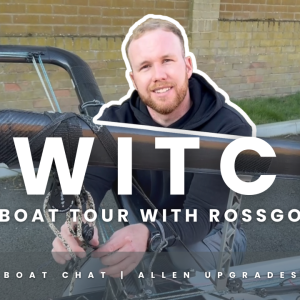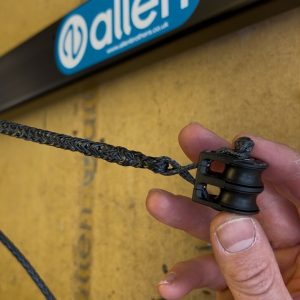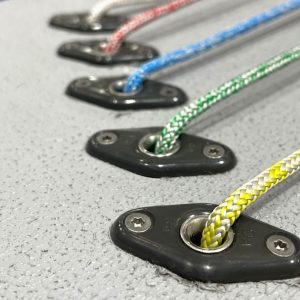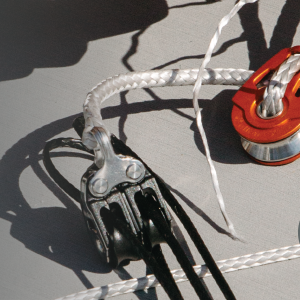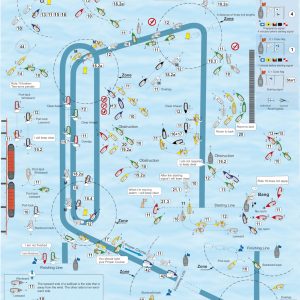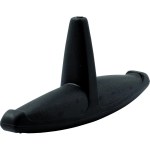Trapeze Harness Trial – Keyball & Quick Release
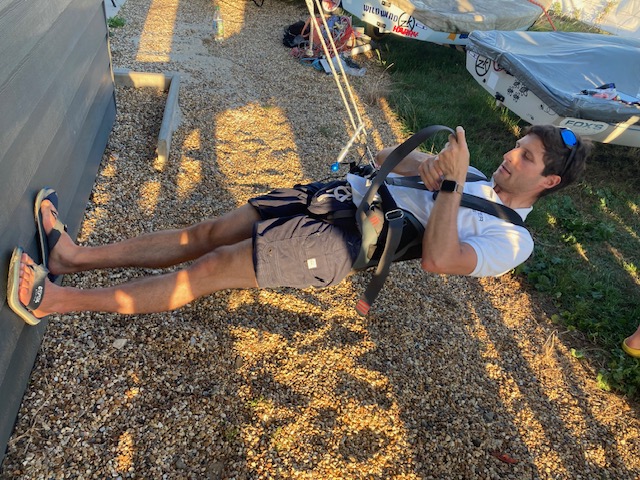
This report and testing have been undertaken by Luke McEwen of the RS800 Class Association. Allen Brothers had no input, persuasion or interaction in any way with the tests that were held. Allen Brothers has in no way edited or altered the below report. This report is specifically intended to help users make an informed choice when choosing a trapeze harness.
Although dinghy sailing is a relatively safe sport, many trapeze sailors would like to have the peace of mind afforded by a quick-release or hook-free harness, to minimise risk of entrapment during a capsize. With two trapeze sailors in every RS800, our class association decided to run a trial of some of the most popular quick-release and hook-free harnesses currently available. At our Nationals in Brightlingsea SC and the Inlands at Grafham Water SC, we set up trapeze lines on shore so all the RS700 and RS800 sailors there could try out the comfort of each harness and the ease of engagement and release of the trapeze:
Rooster trapeze harness with Allen Keyball system.
Zhik T3 harness with Allen Keyball system.
Magic Marine Pro Racing harness with Magic Marine quick-release hook.
Vaikobi Torque QR harness with Vaikobi quick release hook.
RWO quick release hook (on a sailor’s own harness).
Allen Keyball system
The Keyball system uses a ball-and-socket design developed by Julian Bethwaite and Allen Brothers.
Machined aluminium ball fittings go on each trapeze line in place of the traditional ring and an injection-moulded socket goes on the harness in place of the hook, with a variety of stainless steel back plates to suit different straps. The Rooster and Zhik harnesses are available with the Keyball socket from new, reducing the cost of replacing the standard fixed hook.
Eliminating the hook on the harness hugely reduces the chance of getting stuck on the lower shrouds of a dinghy or the trampoline of a catamaran or skiff, probably the biggest causes of trapeze harness entrapments. Furthermore, as the socket on the harness is made of plastic, risk of scratching or puncturing the hull or centreboard during a capsize is lower.
The downsides of the Keyball system are that the trapeze rings on the boat need to be exchanged for the Keyball fittings (making it less straightforward to swap into someone else’s boat) and it is not as easy to hook on with a pelvic thrust manoeuvre favoured by some experienced sailors.
In our trial the RS800 sailors found that hooking on was very easy, the wide entrance to the socket fitting on the harness meaning that arguably less precision is required than when using a traditional trapeze ring and hook. Furthermore the ball is not sensitive to orientation, unlike a ring which sometimes needs turning 90 degrees to face the hook and can end up turning upside down on its elastic. Hooking on felt positive, with a reassuring “click” as the ball engages with the socket.
Unhooking was equally easy, with the elastic pulling the ball cleanly out of the socket once the sailor was standing up. The ball fitting has a flexible neck with a steel wire inside, to allow full articulation as the sailor moves around on the trapeze. There is no integral sheave at the top so sailors who prefer a 3:1 adjuster may want to connect a micro block to the top of the ball fitting.
Magic Marine quick-release hook.
For those who prefer a traditional hook and ring style trapeze, a releasable hook is a potential way to escape an entrapment situation. Magic Marine have evolved their design from a previous iteration in which all the load was carried by a removable double-ended pin: in their current design, most of the weight of the sailor is carried by two fixed pegs below the hook, with a single removable pin above. In our trial we found that the pin was relatively easy to remove even under some load, by pulling on the large webbing toggle. Our sailors felt that accidental release was unlikely as the pin is held in place by elastic and the toggle is located with Velcro on top of the spreader bar. If the load on the trapeze is pulling straight up towards the sailor’s face or twisting the hook, sometimes the hook would not come off the fixed pins as easily.
When the hook is released under load it can fly off quite quickly and would tend to sink, so buying a spare hook would be advisable. Magic Marine also sell the spreader bar complete with quick-release hook as a standalone product to allow people to convert existing harnesses.

Vaikobi quick release hook.
The new Vaikobi QR hook and spreader bar appear to be strikingly similar to the Magic Marine design. There are some subtle differences in shape, meaning that the Vaikobi and Magic Marine hooks are not interchangeable. Our sailors found that the Vaikobi hook had more of a tendency to stay engaged on the fixed pins with an upwards load even after the release pin had been pulled out. Accidental release was considered unlikely with elastic holding the pin in place and the toggle tucked under a Velcro strap. The relatively narrow toggle was less easy to find and get a grip of when wearing gloves.
The Vaikobi harness does come with a spare hook. Vaikobi are based in Australia but now have a
warehouse in the Netherlands and plan to hold stock in UK in future; delivery of the demo harness
only took a few days.

RWO quick release hook.
The oldest of the three quick release hook designs on trial was the RWO hook, which uses a red plastic push-button to release two fixings inside the mechanism. Like the Allen Keyball system, the RWO hook is available on different spreader plates to suit a variety of existing harnesses. The hook also has a hole at the top so a lanyard could be attached to prevent the hook from flying away and sinking, although such a lanyard would need to be cut or broken to allow full release in an entrapment situation. In our trial we found it was very difficult to push hard enough on the button when there was any significant load on the hook.
-
 Trapeze & Vang Clamcleat£15.30 – £16.60
Trapeze & Vang Clamcleat£15.30 – £16.60 -
 Narrow Trapeze Ring With Plain Bearing Block£21.65
Narrow Trapeze Ring With Plain Bearing Block£21.65 -
 Wide Trapeze Ring With 20mm B/B Block And S/S Ring£41.71
Wide Trapeze Ring With 20mm B/B Block And S/S Ring£41.71
Harness comfort
Harness comfort is a very personal choice depending on body shape and not many shops stock a wide range of harnesses so this was a great opportunity for RS800 sailors to try before they buy. Because everyone has their own preferences, the notes below are only a guide and it’s always best to try lying and crouching in a harness on a trapeze wire or rope set up in the shop. Key points to look for are:
Support to the back and shoulders – a good harness requires very little tension in the
shoulder strap. Lie back on the trapeze for a few minutes to see how hard your stomach
muscles have to work.
Lumbar support – all the harnesses in our trial were available with some stiffened back
support, some adjustable, others fixed.
Spreader bar versus narrow plate – spreader bar harnesses are intended to reduce hip
compression but some sailors find a narrower hook plate helps with back support as the
tension can then reach further up around their ribs towards the shoulders.
Pinch points around the crotch area – this can depend on the shape of your body, the cut of
the leg holes, adjustability of any thigh straps and how they are connected to the hook plate
or spreader bar (some straps are joined together leaving a small triangle around the crotch,
others are spaced further apart).
Adjustability versus ease of getting in and out – harnesses with many straps can take a long
time to get into and out of whereas some traditional one-size “nappy” style harnesses (i.e.
without thigh straps) can be slipped straight on but have no adjustability other than the
shoulder strap.
Snagging – harnesses with many exposed buckles give more opportunity to catch on ropes
and trapeze elastic when tacking and gybing. Some harnesses have integral covers over the
buckles, some sailors wear a rash vest over the top of their harness.
Wet weight – RRS 50.1(b) sets a limit of 2kg for wet harnesses unless class rules specify a
higher limit, for example all RS classes and Musto Skiffs allow 2.5kg, to allow for large size
harnesses with lots of padding. The harnesses in our trial claim to have wet weights below
2kg although we did not test this.
Rooster Trapeze Harness.
Our sailors generally found the Rooster harness the most comfortable of the “nappy” style harnesses in the trial. Adjustment is provided by Velcro flaps plus rope lashings to 3 separate points on each side. Depending on body shape it may be necessary to tighten and loosen the lashings when putting the harness on and off. An optional lumbar support pad is available to buy separately in two different lengths; this can be fixed inside the back of the harness with Velcro to suit user preference. Generally our sailors preferred the longer pad. The Rooster harness has interchangeable spreader bars and can be bought with a fixed hook, RWO quick-release hook or Allen Keyball socket.
-
 Rooster Keyball Trapeze Harness£271.24
Rooster Keyball Trapeze Harness£271.24
Zhik T3 Harness.
The Zhik T3 harness has large Velcro flaps each side for quick and easy adjustment as well as getting in and out. The Velcro flaps have their own “quick release” system, although that does not in itself make the harness removable easily if a buoyancy aid or rash vest is worn over the top, as one side of the shoulder strap still needs to be pulled out from an arm hole on the overgarment and then the whole harness pulled out between the legs. The zipped enclosure for the spreader bar allows it to be exchanged e.g. for a spreader bar with a fixed hook, RWO hook or Allen Keyball socket. A lumbar support pad is supplied as standard and can be fixed inside the back of the harness with Velcro to suit user preference. Some of our sailors said that they found the Zhik harness uncomfortable around the crotch area.
Magic Marine Pro Racing Harness
The Magic Marine Pro Racing harness has well-padded thigh straps which are each connected separately to the spreader bar, leaving a generous crotch space between them. Lumbar support stiffening is built into the harness. The side buckles are covered to reduce risk of snagging. Note that Magic Marine also offer two “nappy” style harnesses but these are not currently sold with a quick-release hook.
Vaikobi Torque QR harness.
The Vaikobi Torque harness has thigh straps joined together at the spreader bar. Two long battens up the sides provide lumbar support which, although not adjustable, seemed to be comfortable for our sailors in our trial on land. Some of the buckles are covered to reduce risk of snagging, using a flap held by another buckle. The harness came with a spare hook and a very sharp safety knife tucked into a pocket on the shoulder strap.
-
 Nylon Trapeze Handle ‘T’ Type£4.31
Nylon Trapeze Handle ‘T’ Type£4.31 -
 6mm Wire Trapeze Ring£20.41
6mm Wire Trapeze Ring£20.41 -
 5mm Wire Trapeze Ring£16.04
5mm Wire Trapeze Ring£16.04
The ISO standard for quick release harnesses.
World Sailing’s attempts to make quick release trapeze harnesses compulsory through racing rule 50.1(c) have been postponed again to January 2025, because certification to the ISO 10862 standard mandated in that rule has proven too difficult and expensive for manufacturers to achieve, ever since it was published in 2009.
There’s still no sign of a compliant harness on the horizon, which has left sailors in limbo, not wanting to invest hundreds of pounds in a non-ISO quick release harness in case it becomes illegal for racing in a year or two. Meanwhile they are continuing to sail with fixed-hook harnesses.
Another important aspect World Sailing seem to have overlooked is that hook-free systems such as the Allen Keyball are treated the same as fixed hooks in the standard, as it focusses on release from the trapeze rather than the probably higher risk of catching a hook on other parts of the boat. So unless a class rule specifically permits hook-free systems, they are currently due to become illegal for racing along with fixed hooks and non-ISO quick release hooks.
Paradoxically rule 50.1(c) and the stringent ISO standard have for now increased the risk which World Sailing was seeking to reduce. Hence our decision to run a trial of the currently available non ISO compliant harnesses.
Conclusions
Overall the trial achieved its aims in educating the sailors on the options available. Each of the four harnesses suited some of the RS800 sailors for comfort and ease of use, but this was very much personal preference. Of the three quick-release hooks in our trial, the Magic Marine hook seemed to be the easiest and most reliable to release under load in different directions. As an alternative to a releasable hook, the Allen Keyball system appears to circumvent the problem of hook entrapment with the rigging or trampoline as well as reducing risk of damage to the boat. In our trial it seemed easy to use and has now been bought by at least two of the sailors in the trial.
We very much hope that World Sailing stops their repeated postponement of the current rule and instead makes progress with implementing a practical rule that harness suppliers and class associations can work with, so racing sailors everywhere can benefit. In the meantime, one option to give sailors the confidence to buy a safer trapeze system now would be for class associations of trapeze dinghies to pre-emptively permit hook-free systems as an alternative to quick release harnesses, in case rule 50.1(c) does actually take effect in January 2025 as currently planned.
Disclaimer
None of the manufacturers were directly involved in our trial apart from supplying their demo kit. Opinions from the triallists on harness comfort and ease of use were personal opinions. This report of our trial was written in good faith to help sailors make an informed decision, but sailors must always remain responsible for their own choices affecting the safety of themselves and their crew.
The authors and the RS800 class association cannot accept responsibility for any errors or omissions.
For any more information about any of the information in this post, please contact marketing@allenbrothers.co.uk
Photo credits
RS800 trapeze harness trial: Luke McEwen
Rooster harness with RWO hook: Rooster
Magic Marine Pro Racing harness: Magic Marine
Vaikobi Torque QR harness: Vaikobi
MORE NEWS
